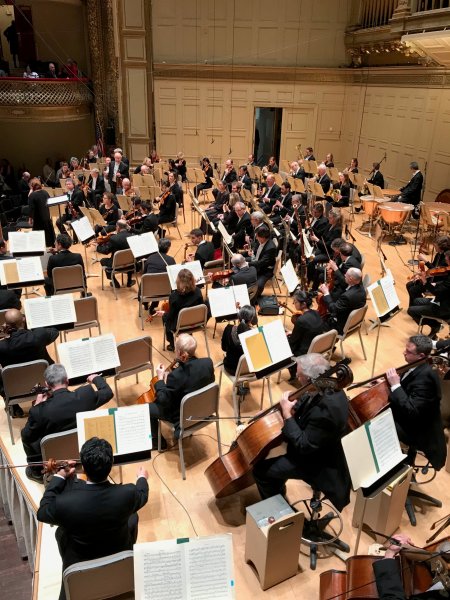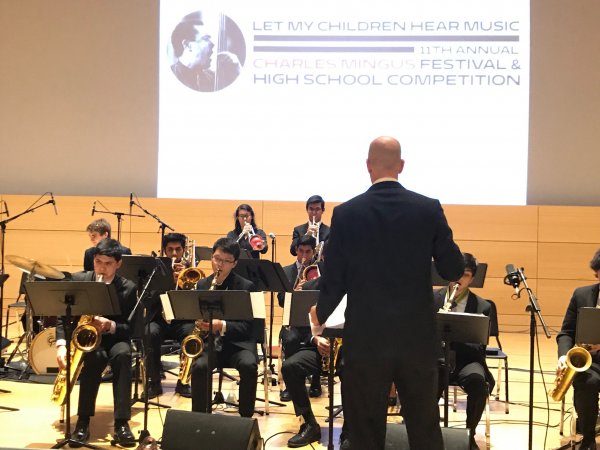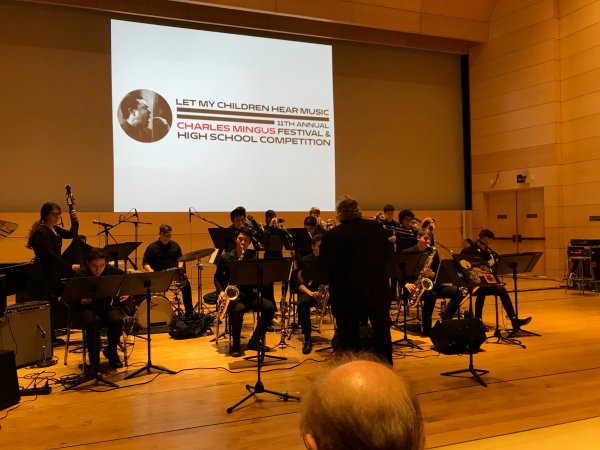Those of us who only care to reproduce the recording largely believe that the microphones capture a different version of reality than what we typically hear as audience/spectators. I am one of those, with one twist...
At the urging of my fellow audio buddies here, I attended a Schumann piano concerto with Yuja Wang, and then, Brucker's #9 with the BSO, sitting in the first balcony, seat A2, the closest seat to the orchestra, and in fact right over it as seen below, and notice where the microphones are (a few over the violins; three over the flutes and other small-wind; two over the timpani; two+two over the larger winds (can't see the trombones or tuba sitting behind the contrabasses, to the right of me)):

The sound was exactly as I had expected: in-your-face, bold, tremendous midrange body courtesy of the hall, the conductor has the best seat in the house (all instruments face him), beautiful tone, not as resolving in detail as the typical recordings I hear at home, not bright from where I sat or anywhere else in the hall before, but... this is just NOT what the microphones pick up, plain and simple. For example, the flute has always sounded small and subdued from anywhere I have ever sat, yet typical good recordings pick that up really well. Ditto for piccolo and all its brightness. By contrast, trombones sounded extremely loud live (even out of sight), yet this is not how most recordings sound. Keep in mind I have many BSO recordings as reference here.
The sound engineer had carefully placed three microphones close to the flutes; he was obviously looking to pick up the right balance, NOT what the audience hears. The microphones have a better perspective than anyone in the audience, and closer to what the conductor hears. I am convinced yet again that recordings capture an event entirely different than what we hear, though there is nothing wrong with either.
So do I still want to reproduce the recording? Well, yes, it's all I have. But, the problem is that a number of them sound unnatural in a number of ways: bloated chest-pounding bass (nothing like that in real life); overly bright; etc. So my goal right now is to have a more midrangy sound than ever before (how to achieve that is not part of this post). This does NOT mean I favor a dark system sound (where the treble is effectively missing), but one with articulated treble that is not as pronounced; basically, a more midrangy tonal balance. At the same time, timbral accuracy continues to be my top requirement.
The following day I went to New York to attend a high school Jazz competition, sitting in two different places. The first, right in front of all brass, and the sound was really dynamic and bright. The second, on the side, where the brightness abated - same first row in both. But alas, the microphones were right on the instruments. Again, they capture a different version of reality:


One common trait between all of these concerts was the in-your-face, very literal sound, and what such microphone positions typically capture. This is one reason I usually don't care much for systems that constantly render a rather recessed perspective, or others that offer a chaotic and diffuse soundstage. I like systems that vastly change character between recordings - which I consider truer to the source - without an exaggerated, yet still resolving treble. Of all speakers I have heard thusfar, the only one that I truly feel does treble right is the Magico M3 driven by the Spectral DMA-500AR amps, and I have to assume the M6 as well.
Fun weekend!
-ack
At the urging of my fellow audio buddies here, I attended a Schumann piano concerto with Yuja Wang, and then, Brucker's #9 with the BSO, sitting in the first balcony, seat A2, the closest seat to the orchestra, and in fact right over it as seen below, and notice where the microphones are (a few over the violins; three over the flutes and other small-wind; two over the timpani; two+two over the larger winds (can't see the trombones or tuba sitting behind the contrabasses, to the right of me)):

The sound was exactly as I had expected: in-your-face, bold, tremendous midrange body courtesy of the hall, the conductor has the best seat in the house (all instruments face him), beautiful tone, not as resolving in detail as the typical recordings I hear at home, not bright from where I sat or anywhere else in the hall before, but... this is just NOT what the microphones pick up, plain and simple. For example, the flute has always sounded small and subdued from anywhere I have ever sat, yet typical good recordings pick that up really well. Ditto for piccolo and all its brightness. By contrast, trombones sounded extremely loud live (even out of sight), yet this is not how most recordings sound. Keep in mind I have many BSO recordings as reference here.
The sound engineer had carefully placed three microphones close to the flutes; he was obviously looking to pick up the right balance, NOT what the audience hears. The microphones have a better perspective than anyone in the audience, and closer to what the conductor hears. I am convinced yet again that recordings capture an event entirely different than what we hear, though there is nothing wrong with either.
So do I still want to reproduce the recording? Well, yes, it's all I have. But, the problem is that a number of them sound unnatural in a number of ways: bloated chest-pounding bass (nothing like that in real life); overly bright; etc. So my goal right now is to have a more midrangy sound than ever before (how to achieve that is not part of this post). This does NOT mean I favor a dark system sound (where the treble is effectively missing), but one with articulated treble that is not as pronounced; basically, a more midrangy tonal balance. At the same time, timbral accuracy continues to be my top requirement.
The following day I went to New York to attend a high school Jazz competition, sitting in two different places. The first, right in front of all brass, and the sound was really dynamic and bright. The second, on the side, where the brightness abated - same first row in both. But alas, the microphones were right on the instruments. Again, they capture a different version of reality:


One common trait between all of these concerts was the in-your-face, very literal sound, and what such microphone positions typically capture. This is one reason I usually don't care much for systems that constantly render a rather recessed perspective, or others that offer a chaotic and diffuse soundstage. I like systems that vastly change character between recordings - which I consider truer to the source - without an exaggerated, yet still resolving treble. Of all speakers I have heard thusfar, the only one that I truly feel does treble right is the Magico M3 driven by the Spectral DMA-500AR amps, and I have to assume the M6 as well.
Fun weekend!
-ack






